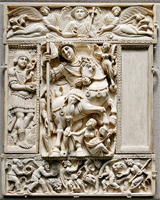
This page created 10 April 2014, and last modified: 30 November 2014 (Froben edition picture added)

In the eastern half of the empire, the 7th of the 17 units of unit of auxilia palatina listed (12.29 in Ingo Maier's numbering scheme) under the command of the second Master of the Soldiers in the Imperial Presence (i.e. the Magister Militum Praesentalis II) is called the Sagittarii iuniores Orientales. The corresponding shield pattern (11#5) as shown in various manuscripts, under the matching label (11.e) Sagittarii iuniores Orientales, is as below:

The pattern has a red rim, two white bands immediately inwards (the outer is yellow in W, and missing in B) and a purple main ground (indigo in P, and faded to a pinky maroon in M, W). The boss is yellow and encircled with a white band (light blue in P, dark blue in W, and pinky-maroon (i.e. faded purple?) in M) which is in turn encircled by a yellow band. A white rectangular imago (imperial portrait) occupies the 12 o'clock position (absent in W) bearing two small figures in black ; flanking the boss are two winged Victories, also in black (absent in B). This shield pattern is thus similar to that of the next unit assigned to the same command, that of the Sagittarii dominici, and it is also very similar to other Sagittarii units, under the other Master of the Soldiers in the Imperial Presence, as the following patterns taken from the Paris manuscript should help to illustrate (except the middle one, which is taken from the Froben edition; the reasons for which are to be found here):

These shield patterns, showing a pair of winged Victories flanking what appears to be an image of an imperial couple (or, in the case of the Sagittarii dominici, a single lord), are all very similar, and clearly form a set of related units. Interestingly, two other eastern units show similar paired Victories: the Domestici equites and the Domestici pedites, under the commands of the Count of the Household Horse and Count of the Household Foot, respectively.
Paired Victories flanking an imperial image are a characteristic late Roman motif, and can also be found on. e.g. the Arch of Constantine (although in this case the imperial image has been lost; single Victories are also used on the same monument). The motif continued into the Byzantine era; the picture below of the early-6th century Barberini ivory in the Louvre shows how the Victories have been transformed into angels, and are now flanking a heavenly Christ rather than the earthly emperor.

Photo by Marie-Lan Nguyen and released into the public domain.
The name Sagittarii iuniores Orientales implies (but does not establish) they are bow-armed, and that the unit was recruited or otherwise came from somewhere in the East.

Return to the Notitia alphabetical unit list page.
Return to my Notitia index page.